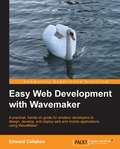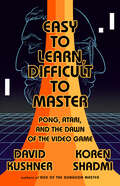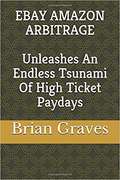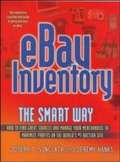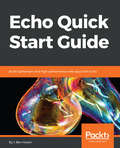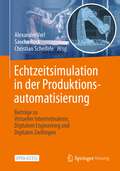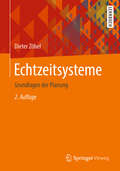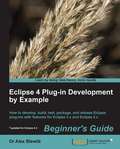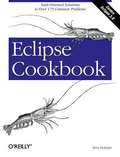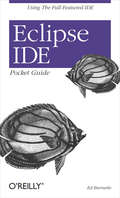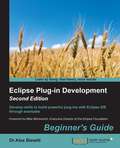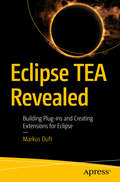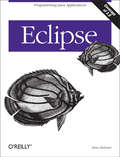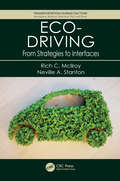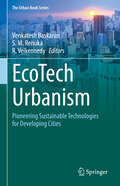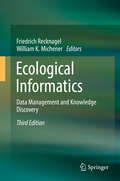- Table View
- List View
Easy Web Development with WaveMaker
by Edward CallahanWritten as a practical Packt tutorial, this essential reference will help you use WaveMaker to design, develop, and deploy rich, responsive web applications. This book is for 'citizen developers'; amateur developers who want to build modern, responsive, but scalable web applications connected to database, REST, and Java services without all the effort. No specific technical knowledge is assumed. However, you will be interacting with numerous technologies throughout the course of this book. The more of those technologies you are familiar with, the easier you will find this book. This book is also good for developers looking to use WaveMaker as a tool to build quickly build AJAX browser clients to their web and Java services using the Spring Framework
Easy to Learn, Difficult to Master: Pong, Atari, and the Dawn of the Video Game
by David KushnerThe gripping origin story of Pong, Atari, and the digital icons who defined the world of video games.A deep, nostalgic dive into the advent of gaming, Easy to Learn, Difficult to Master returns us to the emerging culture of Silicon Valley. At the center of this graphic history, dynamically drawn in colors inspired by old computer screens, is the epic feud that raged between Atari founder Nolan Bushnell and inventor Ralph Baer for the title of &“father of the video game.&” While Baer, a Jewish immigrant whose family fled Germany for America, developed the first TV video-game console and ping-pong game in the 1960s, Bushnell, a self-taught whiz kid from Utah, put out Atari&’s pioneering table-tennis arcade game, Pong, in 1972. Thus, a prolonged battle began over who truly spearheaded the multibillion-dollar gaming industry, and around it a sweeping narrative about invention, inspiration, and the seeds of digital revolution.
Eat, Drink, Animate: An Animators Cookbook
by Tom SitoTom Sito (the legendary animator behind Who Framed Roger Rabbit, Beauty and the Beast, and other classic works) brings together the perfect fusion of culinary skill and animation in his cookbook, Eat, Drink, Animate: An Animator's Cookbook. Sito’s book is a celebration of the works from legendary animation artists from around the world. Twelve Academy Award winners, five Emmy Award winners. From legendary animators from Hollywood’s Golden Age, to modern masters. Not only does he demonstrate examples of their works, but he also includes their favorite personal recipe, and an anecdote from their professional lives that relates to food. Key Features: A rare look behind the scenes of some of animation's most memorable films. Usable recipes you canmake yourself, tested and adapted by Rebecca Bricetti, former editor for Stewart, Tabori, & Chang (Glorious Food ) and Robert Lence animator and gourmet (Toy Story, Shrek). Never before seen photos and illustrations. Anecdotes from behind-the-scenes of some of your favourite animated classics.
Ebay 2014. Por Qué No Está Vendiendo Nada En Ebay Y Qué Puede Hacer Al Respecto
by Nick Vulich Mariana Barrancos¿Quiere ganar dinero vendiendo en eBay?eBay 2014 es el manual que faltaba para aprender a ganar dinero vendiendo en eBay. Los vendedores diarios se debaten sobre las siguientes preguntas: ¿Cómo vender? ¿Qué vender? ¿Cómo mantenerse actualizado con todos los cambios de eBay? Si realmente quiere triunfar en eBay, deberá ser capaz de manejar todos estos temas. eBay 2014 analiza las nuevas actualizaciones para vendedores de eBay y cómo inciden en su negocio. Abarca los problemas actuales que tienen los vendedores de eBay con la visibilidad de las publicaciones, las imágenes, los precios y mucho más. Aprenda a: *Redactar descripciones eficaces *Tomar imágenes que venden *Poner precio a sus artículos para la venta *Manejar los métodos de contabilidad de eBay Léalo hoy libere todo su potencial de ventas.¿Está cansado de los mismos consejos de siempre que brindan los libros sobre eBay, escritos por personas que no conocen la diferencia entre una publicación de subasta y una de precio fijo? Quince años como vendedor destacado de eBay le da a Nick una perspectiva única sobre cómo vender en eBay. La serie The eBay Selling Made Easy le dice las cosas como son. Freaking Idiots Guide to Selling on eBay y eBay Unleashed le indicarán cómo comenzar a vender en eBay. Le mostrarán cómo abrir una cuenta en eBay y PayPal, y lo guiarán de la mano para que pueda hallar productos para vender y concretar su primera venta.eBay 2014 cambia un poco y habla sobre algunas técnicas de venta más avanzadas, y cómo trasladar sus ventas fuera de eBay. Si alguna vez pensó en vender en Amazon, Etsy o eCrater, este libro y Sell It Online (Vender en Internet) le darán más información acerca de cómo hacer la transición de su negoc
Ebay Amazon Arbitrage: Unleashes an Endless Tsunami of High Ticket Paydays
by Brian GravesUnleashes An Endless Tsunami Of High Ticket Paydays Book Description Underground Amazon seller discovers the magical missing word and unleashes an endless tsunami of high ticket paydays. I will provide you with full details of the niche I make money in. I made $82 on the first Item. I bought more from the same seller until I’d bought over 100 Items from him, making between $70 and $150 on each product. I take you through a case study where I show you exactly how to do it. Templates are also provided where necessary to make things as simple as possible. What You Will Learn Buying offline to sell on Ebay and Amazon Buying on other sites to sell on Ebay and Amazon Even more arbitrage tactics to add to you arsenal Case study to show you the exact steps Finding Your Niche And loads more....
Ebay Desatado: Guía Para Principiantes Para Ganar Dinero En Ebay
by Nick Vulich Miguel Segura¿Alguna vez has querido vender en eBay, pero no tenías claro cómo empezar?eBay Desatado es tu guía personal para ganar dinero en eBay. El autor, Nick Vulich, ha completado más de 29.000 transacciones en eBay en los últimos trece años y conoce los pormenores de la venta en eBay y se ofrece para acompañarte de la mano por el proceso de venta.¿Te preocupa no tener nada que vender?No te preocupes. Echa un vistazo a tu alrededor. Todo el mundo tiene docenas de objetos por su casa y en el garaje que puede empezar a vender hoy. Sólo porque ya no no lo utilices tú para tu viejo VCR, sistema de juego, o portátil eso no significa que alguien no lo quiera. La gente ama llevarse una ganga. Ayúdales a conseguir lo que quieren y gana algo de dinero también.En este libro, vas a aprender cómo:1) Decidir qué vender2) Cómo configurar tu cuenta de vendedor de eBay3) Cómo configurar tu cuenta de PayPal (para poder recibir el pago rápido)4) Instrucciones paso a paso de cómo anunciar tu primer artículo en eBay5) Veintiocho consejos y trucos para potenciar tu venta6) Cómo enviar tus artículos7) Cómo investigar los artículos para poder conseguir el mejor precio siempre8) Una introducción al servicio al cliente - al estilo eBayNo dejes que el miedo a lo desconocido te eche para atrás1) Se estima que más de 450.000 personas trabajan vendiendo artículos en eBay a tiempo completo2) Unos millones más de personas utilizan eBay para hacer algún dinero extra para comprarse un coche nuevo, pagar el colegio de sus hijos o hacer unas vacaciones de ensueño - ¿por qué no tú?3) Otros millones más gente querrían vender en eBay, pero tienen miedo de intentarlo4) eBay desatado te guiará paso a paso en la decisión de decidir qué vender, registrarte en una cuenta de eBay y PayPal, para anunciar tu primera subasta.
Ebay Inventory the Smart Way: How to Find Great Sources and Manage Your Merchandise to Maximize Profits on the World's #1 Auction Site
by Joseph T. Sinclair Jeremy HanksCorresponding to the ongoing trend of making money using eBay, this book focuses on inventory sources and suggests tips for deciding on and finding products, cost-effectiveness, inventory management software, supplier-retailer relationships, shipping methods including drop shipping, consignment, and various sources for finding products such as trade markets and organizations, manufacturers, wholesalers, inventory services, closeouts, directories, picking, local sources, arts and crafts, packaging, special products, and using eBay itself. Also discussed are scams, foreign goods, and pawnshops. No bibliography is provided. Sinclair is author of all of the books in the "eBay the Smart Way" series; Hanks is cofounder and CEO of a drop shipper in the online product sourcing industry. Annotation ©2006 Book News, Inc., Portland, OR (booknews.com)
Ebay Rescue Profit Maker
by Kevin W. BoydPump up your profits on eBay®! When many eBay® sellers run out of items to sell, they often head straight to the outlet malls looking for super sales, or go to trade shows, or shop online liquidation sites looking for larger quantities of items, sometimes purchasing pallets of product. Only then do they discover their problem: the items they just purchased are selling on eBay® for less than what they paid! Now they no longer have to repeat this pattern with costly hit-or-miss results. In this guide, an eBay® PowerSeller shares the proprietary product selection and evaluation methodology he has developed based on seven years of professional eBay® selling, instructing, and consulting. In eBay® Rescue Profit Maker, readers learn how to:• Determine what to sell • Determine the reputable product suppliers • Create enticing listings and use advanced listing techniques • &“Spy&” on their competition • Provide superior customer service • Expand and improve their customer base
Ebay Scatenato Guida Per Il Principiante Che Vuole Fare Soldi Su Ebay
by Nick Vulich Luisa Agnese Dalla FontanaHai mai pensato di vendere su eBay ma non sapevi d ache parte cominciare. eBay scatenato è la tua guida personale per fare soldi su eBay, seguendo i consigli dell'autore, che negli ultimi 13 anni ha completato oltre 29.000 transazioni su eBay e ti guiderà passo passo insegnandoti a vendere.Guardati intorno: puoi cominciare a vendere quello che hai in casa e non usi più.Questo libro ti insegnerà adecidere che cosa vendere.Aprire un account su eBayAprire un conto PayPalFare la tua prima inserzione.28 trucchi e spunti per aumentare le venditeEffettuare le spedizioni nel migliore dei modiStabilire il prezzo dei tuoi articoliIl servizio al consumatore nello stile di eBayRicorda che oltre 450.000 persone si guadagnano da vivere vendendo su eBay e milioni se ne avvalgono per integrare gli introiti e potersi permettere un'auto nuova o una vacanza da sogno. Puoi farlo anche tu! Per cominciare ti basterà meno di un'ora. Non aspettare un minuto di più! Ordina la tua copia di questo libro ORA!!!
Ebay, El Negocio De 100.000 $ Consigue Beneficios De Locura Vendiendo En Ebay Y Amazon
by Braun Schweiger Irune Hidalgo¿Estás preparado para ganar dinero online? eBay, el Negocio de 100.000$ es tu entrada para vender en eBay y Amazon. Se estima que actualmente más de medio millón de personas se ganan la vida vendiendo en eBay y Amazon. Tú también puedes. Se trata de empezar e ir haciendo crecer tu negocio. No sabes nada de eBay ni Amazon, no te preocupes. eBay, el Negocio de 100.000$ te ayuda a decidir qué vender, cómo vender y cómo obtener el mayor beneficio posible. Si alguna vez has querido iniciar un negocio propio, la venta online es el mejor modo de empezar. 1. Puedes empezar con una inversión mínima. La mayoría de los vendedores empiezan vendiendo artículos que tienen por su casa. 2. Puedes empezar desde casa, a media jornada mientras continúas con tu trabajo a jornada completa. 3. No hay unas horas establecidas. Si eres un padre o una madre que se queda en casa, puedes vender cuando los niños están en el colegio o después de que vayan a la cama por la noche. 4. Es una ventaja si ya tienes el equipo necesario para empezar. Puedes publicar artículos desde tu portátil, tu teléfono móvil o tablet. Compra un equipo mejor cuando tus ventas aumenten. ¿No estás seguro de qué vender o cómo conseguir productos? No sufras. También lo incluimos aquí. Descubre una larga lista de artículos que seguramente tengas por tu casa para empezar a vender. Explora lugares en los que adquirir inventario localmente, mercadillos, venta de bienes e incluso tiendas minoristas. Los artículos rentables están a tu alrededor. Sólo necesitas saber qué buscar. No sabes nada de vender en eBay ni en Amazon. No hay problema. eBay, el Negocio de 100.000$ explica cómo vender en eBay y Amazon. Aprende todo lo que necesitas saber para empezar y crecer con un negocio online de éxito. Léelo esta mañana Publica tu primer artículo esta tarde Gana dinero mañana
Ebu$iness: 7 Steps To Get Your Small Business Online... And Making Money Now!
by Paul WallbankIs your business website a money pit? A source of frustration? A time-waster? Does your business even have an online presence? It's time to get your website working for you and making money. The web and social media have become the new shopfronts where customers, staff and suppliers look to find people to do business with. eBu$iness will help anyone who wants to set up and maintain a professional web presence by showing you how to: register an effective domain name set up your own free or cheap website use social media to your advantage optimise your website so that search engines and customers can find you take advantage of free local listing services and much more. Whether you already have a website or you're just starting out, eBu$iness gives you the tools and know-how to save time and money, and will help you to grow your business and make a profit.
Echo Dot 3.ª generación manual de usuario: El manual de instrucciones completo de Amazon Echo Dot 3.ª generación con Alexa para principiantes
by Paul O. Garten¿Qué tal vivir a cuerpo de rey, tan solo haciendo solicitudes, sentándote y viendo cómo se llevan a cabo al pie de la letra? Entonces, ¡no te lo pienses más! Ese es el trabajo de Alexa y lo hace como nadie. Lo que Alexa puede hacer depende de cómo la entiendas y, especialmente, cómo entiendes su lenguaje. Sí, Alexa no solo entiende las palabras, sino que comprende una serie de códigos que no se corresponden exactamente con cómo hablamos en nuestro día a día. El libro trata detalles que van desde operar con Amazon Echo Dot (3.ª generación) hasta la manipulación del dispositivo, como, por ejemplo, Entrenamiento de voz con Alexa. Entender los estados del anillo de luz. Conectar el Echo Dot a Internet. Emparejar el altavoz/stereo con Bluetooth Cambiar la palabra de activación. Configurar el Echo Dot en diferentes localizaciones dentro de tu hogar. Configurar alarmas y temporizadores, hora y fecha. Gestionar email y SMS. Skills, Rutinas y Blueprints de Alexa. Llamadas de voz/vídeo con Alexa. Controlar tu TV con Alexa. Hacer que Alexa lea un ebook de Kindle por ti. Vincular tu Calendario. Comprar con Alexa. Eliminar grabaciones de voz del historial de Alexa. Construir un Hogar digital con Alexa. Protocolos IFTTT con Alexa. Jugar con Alexa. Alexa para Niños. Resolver problemas comunes con tu Amazon Echo Dot y Alexa. Y mucho más. Sí, hay más de 100 comandos de voz y más de 100 perlas de Alexa esperándote dentro de tu dispositivo Echo Dot (3.ª generación). No tienes que gastar cientos de euros para tener un asistente personal avanzado como Alexa. Invirtiendo poco tiempo para configurar tu Echo Dot (3.ª generación), conseguirás muchas funcionalidades para tu hogar y hará tu vida más fácil e interesante.
Echo Quick Start Guide: Build lightweight and high-performance web apps with Echo
by J. Ben HusonEcho is a leading framework for creating web applications with the Go language. This book will show you how to develop scalable real-world web apps, RESTful services, and backend systems with Echo. Key FeaturesThe easiest way to learn how to build web apps with EchoBuild a full working projectFor Go developers with only basic web development knowledge requiredBook DescriptionEcho is a leading framework for creating web applications with the Go language. This book will show you how to develop scalable real-world web apps, RESTful services, and backend systems with Echo. After a thorough understanding of the basics, you'll be introduced to all the concepts for a building real-world web system with Echo. You will start with the the Go HTTP standard library, and setting up your work environment. You will move on to Echo handlers, group routing, data binding, and middleware processing. After that, you will learn how to test your Go application and use templates. By the end of this book you will be able to build your very own high performance apps using Echo.A Quick Start Guide is a focussed, shorter title which provides a faster paced introduction to a technology. They are for people who don’t need all the detail at this point in their learning curve. The presentation has been streamlined to concentrate on the things you really need to know, rather than everything.What you will learnKey design considerations for high performance Echo applicationsHow Echo handles routingHow context is managed through the lifetime of the request and response pipelineDecrease complexity of your apps by developing middleware functionsInteract with the request through request data bindingsInteract with the response through response data renderings within the frameworkUse Echo's logging and error handling facilitiesRender Go templates within Echo to allow for server side rendering of contentWho this book is forYou will need to know the basics of the Go language, and the general concepts of web development.
Echtzeitsimulation in der Produktionsautomatisierung: Beiträge zu Virtueller Inbetriebnahme, Digitalem Engineering und Digitalen Zwillingen
by Alexander Verl Sascha Röck Christian ScheifeleDieses Open Access Buch befasst sich in 22 Kapiteln von 41 Autoren aus Wissenschaft und Praxis mit einer Sammlung unabhängiger Beiträge, die den heutigen Stand der Forschung und Technik im Bereich der Echtzeitsimulation von Maschinen und Anlagen aufzeigen. Neben Forschungsergebnissen wird der erfolgreiche Transfer in die Praxis anhand ausgewählter Beispiele vorgestellt. Das Sammelwerk umfasst das Themenspektrum von der Echtzeitsimulation für die Virtuelle Inbetriebnahme über deren Einsatz in der Entwicklungs- und Betriebsphase bis hin zur Nutzung von Simulationsmodellen in Steuerungsfunktionen.
Echtzeitsysteme: Grundlagen der Planung
by Dieter ZöbelOhne unmittelbar in Erscheinung zu treten, steuern Echtzeitsysteme heute Produktionsanlagen, assistieren beim Autofahren oder sichern die Qualität der Sprachübertragung in weltweiten Netzen. Sie greifen in technische Prozesse ein, um sie zum richtigen Zeitpunkt zu den richtigen Aktionen zu bewegen. Das Lehrbuch beschreibt Echtzeitsysteme aus der Sicht der Informatik mit dem Schwerpunkt Real-time Scheduling. Es richtet sich an Studierende der Informatik und Wirtschaftsinformatik. Zahlreiche Aufgaben mit Lösungen helfen, den Stoff zu vertiefen.
Eclipse 4 Plug-in Development by Example Beginner's Guide
by Dr Alex BlewittA Beginner's Guide following the "by Example" approach. There will be 5-8 major examples that will be used in the book to develop advanced plugins with the Eclipse IDE.This book is for Java developers who are familiar with Eclipse as a Java IDE and are interested in learning how to develop plug-ins for Eclipse. No prior knowledge of Eclipse plug-in development or OSGi is necessary, although you are expected to know how to create, run, and debug Java programs in Eclipse.
Eclipse Cookbook
by Steve HolznerYou've probably heard the buzz about Eclipse, the powerful open source platform that gives Java developers a new way to approach development projects. It's like a shiny new car--no longer content to just admire Eclipse, you're now itching to get in and drive. Eclipse is to Java developers what Visual Studio is to .NET developers--it's an integrated development environment (IDE) that combines a code editor, compiler, debugger, text editor, graphical user interface (GUI) builder, and other components into a single, user-friendly application. It provides a solid foundation that enables Java developers to construct and run integrated software-development tools for web development, application design, modeling, performance, testing, and much more. As with any extensive programming tool, however, there's a lot to learn. And there s no better guy than well-known Java expert Steve Holzner to teach you. An award-winning and best-selling author who has been writing about Java topics since the language first appeared, Holzner delivers just the kind of targeted, practical, everyday knowledge you need to hone your mastery of Eclipse. Perfect as a companion to an Eclipse programming tutorial (such as Holzner's own Eclipse , O'Reilly, April 2004) or an ideal stand-alone for all those developers who either don't want or don't need the tutorial approach, the Eclipse Cookbook contains task-oriented recipes for more than 800 situations you may encounter while using this new Java platform--from deploying a web application automatically to reverse engineering compiled code, from re-naming all references to a class across multiple packages to initializing the SWT JNI libraries. Each recipe in the ever-popular and utterly practical problem-solution-discussion format for O'Reilly cookbooks contains a clear and thorough description of the problem, a brief but complete discussion of a solution, and in-action examples illustrating that solution. The Eclipse Cookbook will satiate Java programmers at all levels who are ready to go beyond tutorials--far beyond writing plug-ins and extensions--and actually use the powerful and convenient Eclipse day to day.
Eclipse IDE Pocket Guide: Using the Full-Featured IDE
by Ed BurnetteEclipse is the world's most popular IDE for Java development. And although there are plenty of large tomes that cover all the nooks and crannies of Eclipse, what you really need is a quick, handy guide to the features that are used over and over again in Java programming. You need answers to basic questions such as: Where was that menu? What does that command do again? And how can I set my classpath on a per-project basis?This practical pocket guide gets you up to speed quickly with Eclipse. It covers basic concepts, including Views and editors, as well as features that are not commonly understood, such as Perspectives and Launch Configurations. You'll learn how to write and debug your Java code--and how to integrate that code with tools such as Ant and JUnit. You'll also get a toolbox full of tips and tricks to handle common--and sometimes unexpected--tasks that you'll run across in your Java development cycle.Additionally, the Eclipse IDE Pocket Guide has a thorough appendix detailing all of Eclipse's important views, menus, and commands.The Eclipse IDE Pocket Guide is just the resource you need for using Eclipse, whether it's on a daily, weekly, or monthly basis. Put it in your back pocket, or just throw it in your backpack. With this guide in hand, you're ready to tackle the Eclipse programming environment.
Eclipse Plug-in Development: Beginner's Guide - Second Edition
by Dr Alex BlewittDevelop skills to build powerful plug-ins with Eclipse IDE through examples About This Book * Create useful plug-ins to make Eclipse work for you * Learn how to migrate Eclipse 3.x plug-ins to Eclipse 4.x * From automation to testing, find out how to get your IDE performing at an impressive standard Who This Book Is For This book is for Java developers familiar with Eclipse who need more from the IDE. This book will sharpen your confidence and make you a more productive developer with a tool that supports rather than limits you. What You Will Learn * Create plug-ins for Eclipse 4.x * Test plug-ins automatically with JUnit * Display tree and table information in views * Upgrade Eclipse 3.x plug-ins to Eclipse 4.x * Find out how to build user interfaces from SWT and JFace * Run tasks in the background and update the user interface asynchronously * Automate builds of plug-ins and features * Automate user interface tests with SWTBot In Detail Eclipse is used by everyone from indie devs to NASA engineers. Its popularity is underpinned by its impressive plug-in ecosystem, which allows it to be extended to meet the needs of whoever is using it. This book shows you how to take full advantage of the Eclipse IDE by building your own useful plug-ins from start to finish. Taking you through the complete process of plug-in development, from packaging to automated testing and deployment, this book is a direct route to quicker, cleaner Java development. It may be for beginners, but we're confident that you'll develop new skills quickly. Pretty soon you'll feel like an expert, in complete control of your IDE. Don't let Eclipse define you - extend it with the plug-ins you need today for smarter, happier, and more effective development. Style and approach Packed with plenty of examples so you're never stuck, or never left simply reading instructions, this book encourages you to get started immediately. This book is for developers who want to develop, not just learn.
Eclipse TEA Revealed: Building Plug-ins and Creating Extensions for Eclipse
by Markus DuftDiscover the open source Eclipse Tasking Engine Advanced (TEA) project in this compact to-the-point book. It covers how to automate tasks using TEA and focuses on simplifying and aiding the creation of extensions for the Eclipse IDE in a way which makes them accessible both from the IDE’s UI and in a headless fashion from the command line.Additionally, Eclipse TEA Revealed explores the library of pre-built components included with TEA, mostly in the area of rich client platform (RCP)-based Java application development, for building projects, updating sites, dealing with target platforms, and more. After reading and using this book, you'll be up to speed on the fundamentals of Eclipse TEA and ready to use it for more productive Java-based application builds and developments.What You Will LearnView TEA’s internal architecture Work with TEA’s APIs Write TEA componentsUse the pre-built TEA componentsSet up headless environments using TEAWho This Book Is ForReaders should be Java developers interested in extending the Eclipse IDE and/or setting up headless environments based on Eclipse.
Eclipse: Programming Java Applications
by Steve HolznerJava programmers know how finicky Java can be to work with. An omitted semi-colon or the slightest typo will cause the Java command-line compiler to spew pages of annoying error messages across your screen. And it doesn't fix them--that's up to you: fix them, compile again, and hope that nothing goes wrong this time.Eclipse, the popular Java integrated development environment (IDE) provides an elegant and powerful remedy for this common, frustrating scenario. It doesn't just catch your errors before you compile, it also suggests solutions. All you need to do is point and click. And it's free--what could be better? Still, if you're like most programmers, mastering a new technology--no matter how productive it will make you in the long run--is going to take a chunk out of your productivity now. You want to get up to speed quickly without sacrificing efficiency.O'Reilly's new guide to the technology, Eclipse, provides exactly what you're looking for: a fast-track approach to mastery of Eclipse. This insightful, hands-on book delivers clear and concise coverage, with no fluff, that gets down to business immediately. The book is tightly focused, covering all aspects of Eclipse: the menus, preferences, views, perspectives, editors, team and debugging techniques, and how they're used every day by thousands of developers. Development of practical skills is emphasized with dozens of examples presented throughout the book.From cover-to-cover, the book is pure Eclipse, covering hundreds of techniques beginning with the most basic Java development through creating your own plug-in editors for the Eclipse environment. Some of the topics you'll learn about include:Using Eclipse to develop Java codeTesting and debuggingWorking in teams using CVSBuilding Eclipse projects using AntThe Standard Widget Toolkit (SWT)Web developmentDeveloping Struts applications with EclipseFrom basics to advanced topics, Eclipse takes you through the fundamentals of Eclipse and more. You may be an Eclipse novice when you pick up the book, but you'll be a pro by the time you've finished.
Eco-Driving: From Strategies to Interfaces (Transportation Human Factors)
by Neville A. Stanton Rich C. McllroyEco-driving has the potential to save fuel and reduce emissions without having to make any changes to vehicles or road infrastructure. This book provides an in-depth understanding of the contemporary issues in the human factors aspects of eco-driving strategies and interfaces and the effects on driver behaviour. A review of the literature concerning design, behaviour, and energy use led to an exploration of Ecological Interface Design, and the Skills, Rules, and Knowledge (SRK) taxonomy of human behaviour, particularly with regard to haptic information presented through the accelerator pedal. This book explains that eco-driving can be performed by anyone in control of a vehicle.
EcoTech Urbanism: Pioneering Sustainable Technologies for Developing Cities (The Urban Book Series)
by Venkatesh Baskaran S. M. Renuka R. VelkennedyIn a world experiencing unprecedented urbanization and drastic climate change, there is immense demand for creative solutions to the environmental, social, and economic obstacles faced by burgeoning cities in the developing world. This book delves into the potential of innovative urban initiatives to address the challenges of urbanization in countries with limited resources, thereby contributing to sustainable and inclusive urban development. It explores how cutting-edge technologies can provide efficient functionality for urban residents through information and communications shared among stakeholders. The primary aim is to enhance the efficiency of urban operations, foster economic development, and improve the well-being of residents by leveraging intelligent technologies and analyzing data. Government and policy are recognized as fundamental drivers of urban development, and the book sheds light on initiatives supporting cities that are not only technologically advanced but also sustainable, inclusive, and equitable. Contributions provide insight into technological aspects of urbanism, including the Internet of Things (IoT), sensors, data analytics, and essential infrastructure for sustainable city development. They also emphasize the importance of community engagement and inclusivity, stressing that urban initiatives should be designed for the benefit of all citizens, leaving no one behind. EcoTech Urbanism makes a compelling case for the imperative of sustainability in the future of urban areas, underscoring the critical role of technology in achieving this goal. The book offers a holistic perspective on the integration of eco-friendly technologies, fostering a balance between urban development and environmental conservation, ultimately paving the way for a future where cities thrive sustainably and inclusively.
Ecogames: Playful Perspectives on the Climate Crisis (Green Media)
by Stefan Werning Gerald Farca Joost Raessens Beke, Laura op deWith the climate crisis and its repercussions becoming more and more tangible, games are increasingly participating in the production, circulation, and interrogation of environmental assumptions, using both explicit and implicit ways of framing the crisis. Whether they are providing new spaces to imagine and practice alternative forms of living, or reproducing ecomodernist fantasies, games as well as player cultures are increasingly tuned in to the most pressing environmental concerns. This book brings together chapters by a diverse group of established and emerging authors to develop a growing body of scholarship that explores the shape, impact, and cultural context of ecogames. The book comprises four thematic sections, Today's Challenges: Games for Change, Future Worlds: New Imaginaries, The Nonhuman Turn, and Critical Metagaming Practices. Each section explores different aspects of ecocritical engagement in and through games. As a result, the book's comprehensive scope covers a variety of angles, methodologies, and case studies, significantly expanding the field of green media studies.
Ecological Informatics
by Friedrich Recknagel William K. MichenerEcological Informatics is defined as the design and application of computational techniques for ecological analysis, synthesis, forecasting and management. The book provides an introduction to the scope, concepts and techniques of this newly emerging discipline. It illustrates numerous applications of Ecological Informatics for stream systems, river systems, freshwater lakes and marine systems as well as image recognition at micro and macro scale. Case studies focus on applications of artificial neural networks, genetic algorithms, fuzzy logic and adaptive agents to current ecological management issues such as toxic algal blooms, eutrophication, habitat degradation, conservation of biodiversity and sustainable fishery
